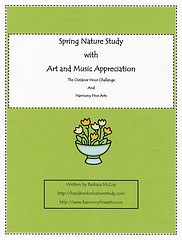Outdoor Hour Challenge
Spring Series #2
Spring Weather Observation
Inside Preparation Work:
- Read pages 851-854 in the Handbook of Nature Study. This section is not exactly about weather, but it ties in nicely with some springtime observations of the sun and its path. You might like to construct the Shadow Stick (page 852 #13) and make observations over the next few weeks and months with your children. At the very least, look up your sunrise and sunset times to calculate how much daylight you have now that it is spring in your area.
- If you have the older edition of the Handbook of Nature Study, you need to look in the section “The Relations of the Sun to the Earth” for this week’s reading.
Outdoor Hour Time:
- Your Outdoor Hour time this week can be spent making observations about the weather. Enjoy whatever spring weather you are currently experiencing and spend 15 minutes outside looking at the sky, clouds, wind in the trees, dew on the grass, mud puddles after a rain, or whatever else you can experience in your part of the world.
- Have your children describe any clouds they see in the sky.
- Notice how hard the wind is blowing by how things are moving: leaves rustling, trees bending, etc.
- Notice the wind’s direction. Where is it coming from?
- Describe the temperature of the air and/or look it up on a thermometer.
- Notice any precipitation that you may have this week: sprinkles, rain, mist, sleet, snow, fog, hail.
- If you made a Shadow Stick, make sure you spend one day marking the board every half hour from 9 AM to 3 PM. This experiment will need to be repeated again in June, September, and December if possible. (see page 852 #13)
Follow-Up Activity:
Be sure to complete your Seasonal Weather notebook page from the Misc Tab or from the Spring Series ebook. If you completed previous weather notebook pages, pull those out and compare the scenes you recorded in Autumn and/or Winter. Note that your days should be getting longer and any other differences you can find between the observations made in the past and now.
Mono Lake Sand Tufa with Wonderful Clouds
Extra Information on Clouds
If you observed any clouds, you might like to download this lesson plan and cloud identifier activity for your children: CloudKey.pdf. This is a handy tool to use in our cloud identification.
Weather Videos on YouTube:
Water Cycle
Our World: What is Weather? (NASA)
If you would like all the Spring Series Challenges in one book, I have an ebook gathered for you to purchase for your convenience. The ebook also contains art and music appreciation plans for the winter months as well. Please see this entry for more details:
Spring Nature Study with Art and Music Appreciation






We are still working on the tree observations, getting the post written, but the Spring Weather was easy enough to post quickly. I am really enjoying having the printed Ebook to help plan ahead!
We’re still waiting for significant changes in our trees to journal about it. We did the weather today and it made for a great study!
Thanks for hosting! =)
Although today is cold and rainy, we were outside yesterday taking a few pictures, and it was nice and sunny 🙂 We also found a few surprises! Thanks Barb!
Oh I love printables! Makes it easy to three hole punch and put in our science notebooks. We had a fun time with this (always do with your challenges) – spread out over two weeks. Thanks again.
The videos in the links you posted are lots of fun! Thanks.
Oh, I love the cloudkey! That looks really neat! We’ll be gearing up for spring weather and clouds next week when we’re back home.
Jessy
I agree…the cloud key is worth printing out. This is an easy-to-use, kid-friendly way to identify clouds. Thanks for posting the link for it, Barb!
We did a couple of experiments that tie into weather – one about learning about a thermometer and temperature; and the other about making a hygrometer (which measures humidity…a common factor in the weather here in Minnesota).